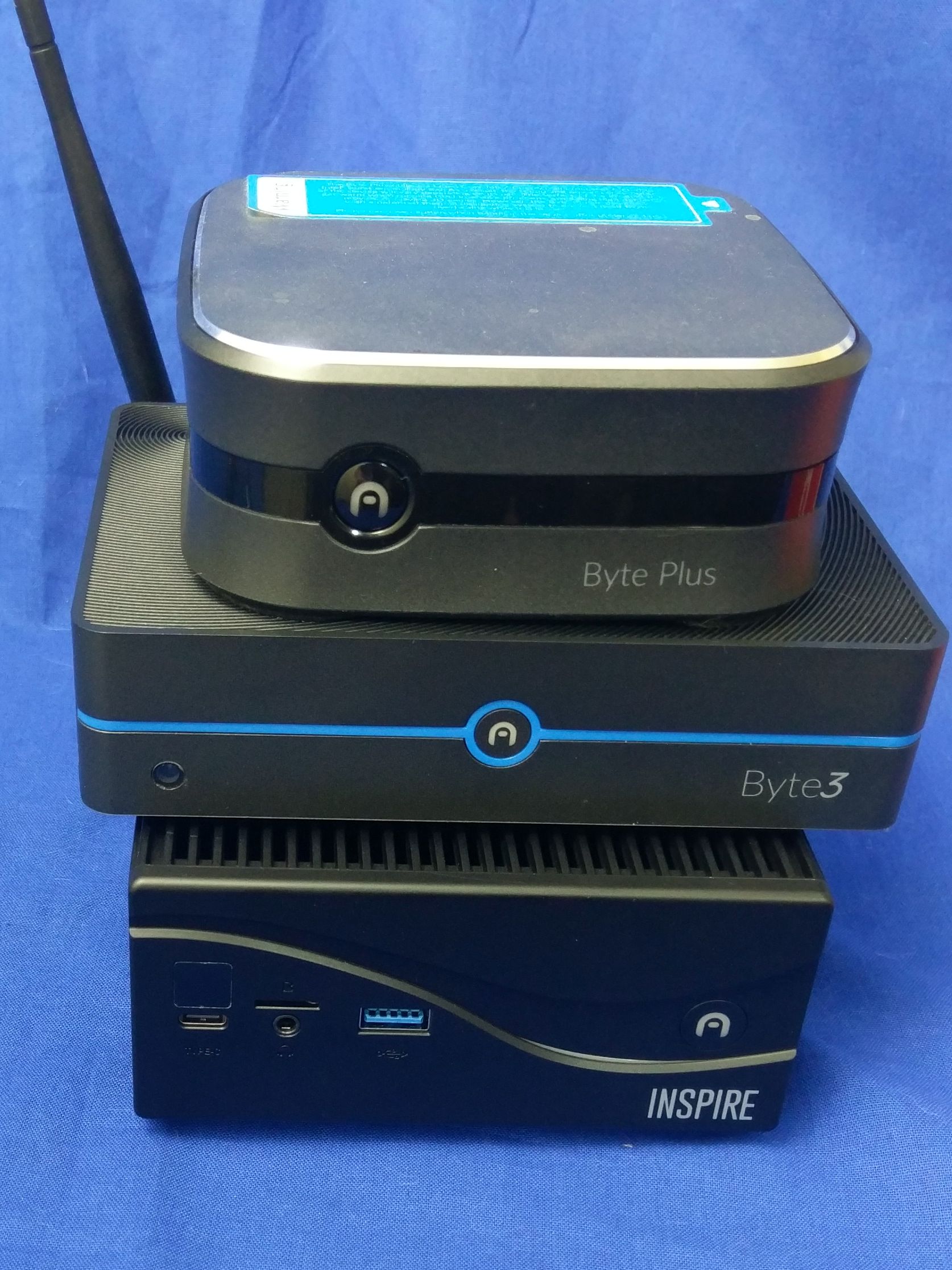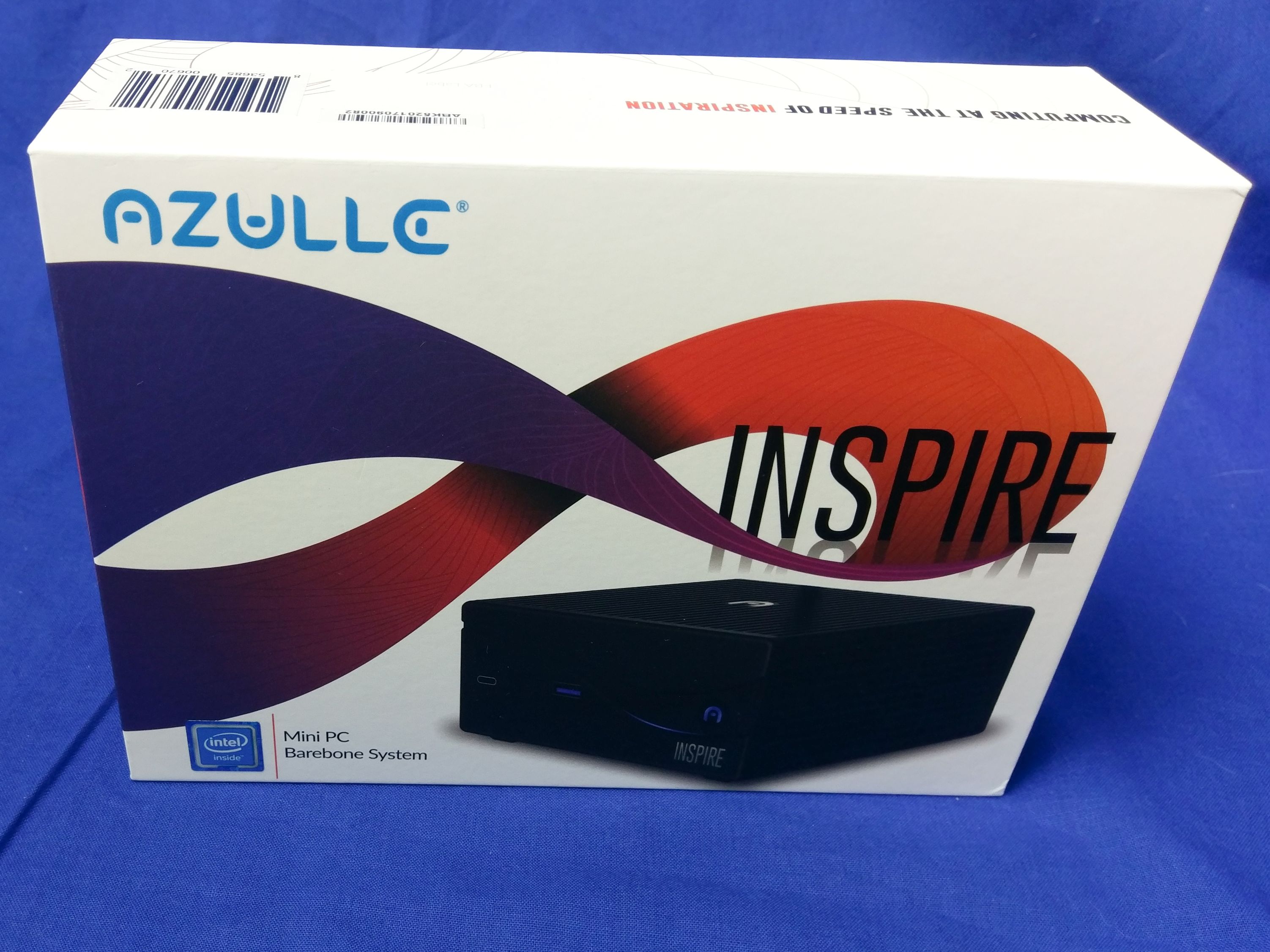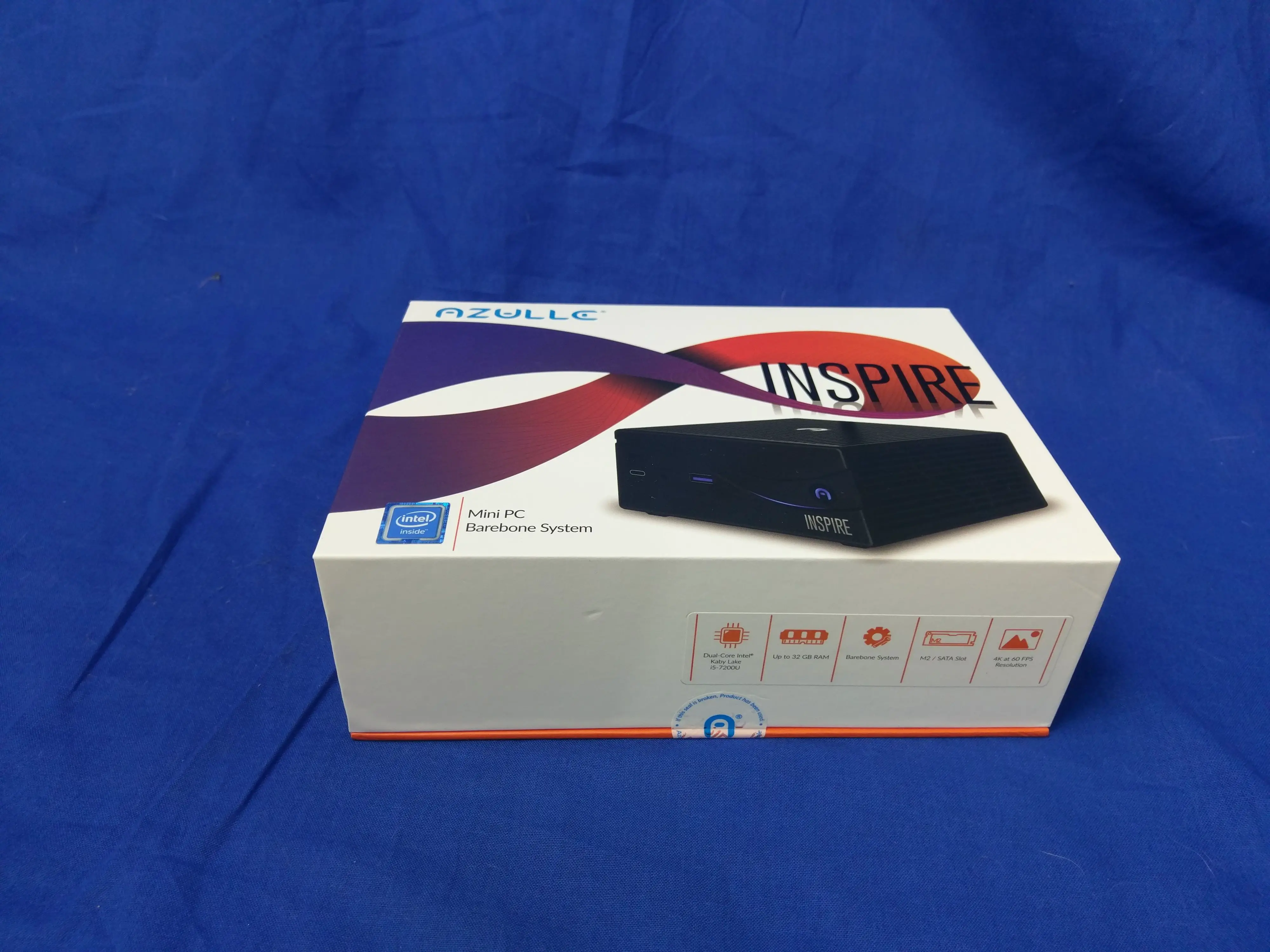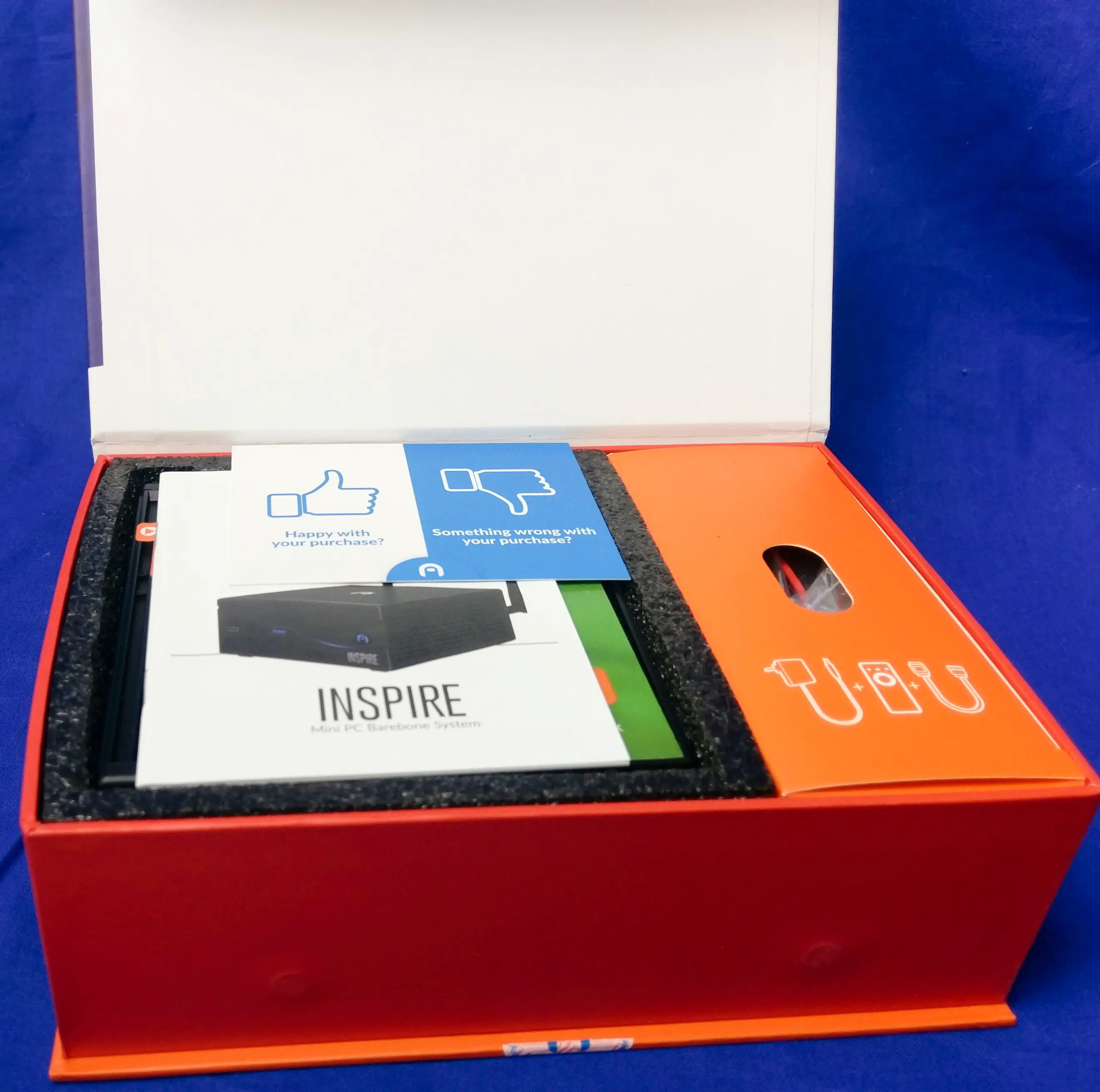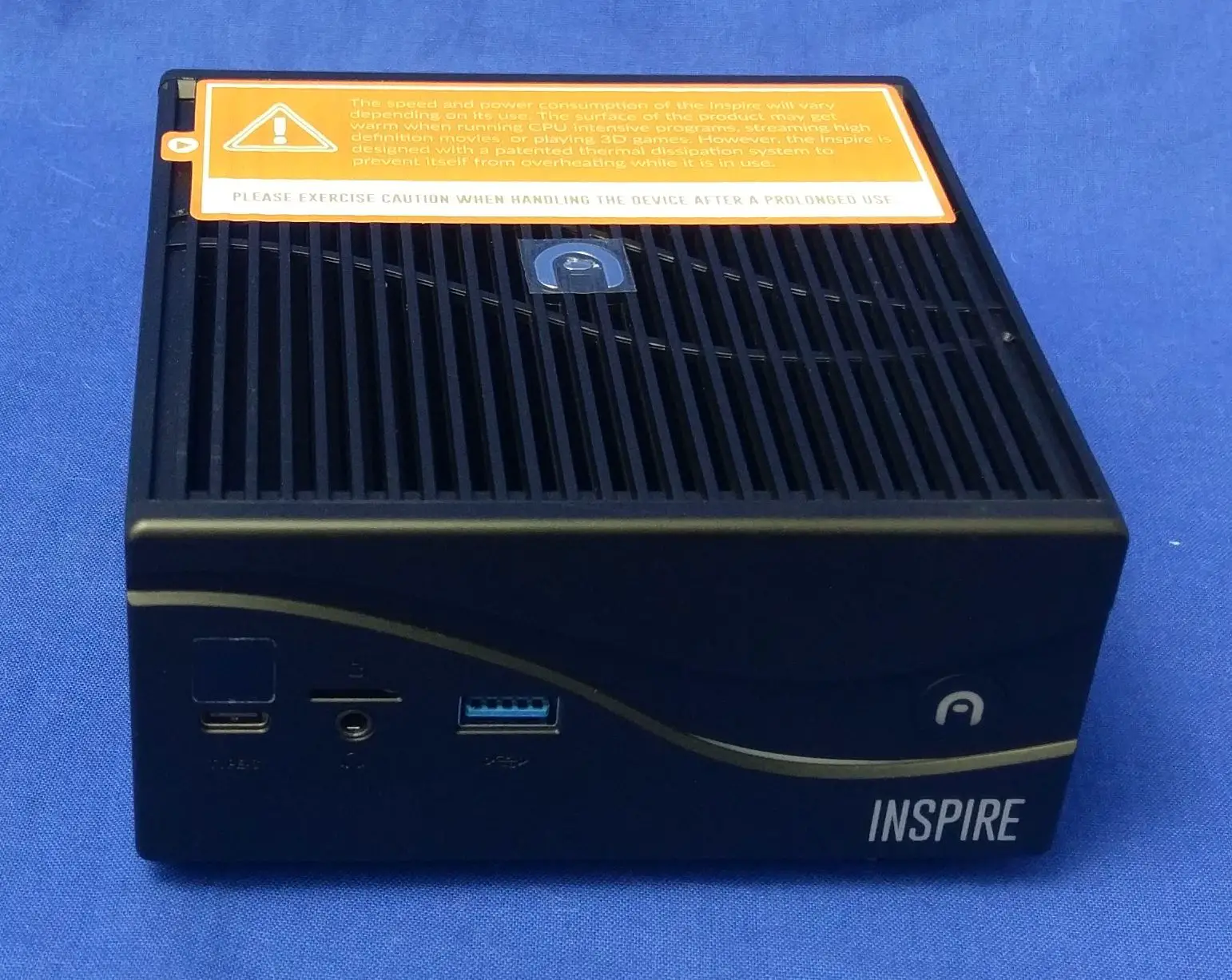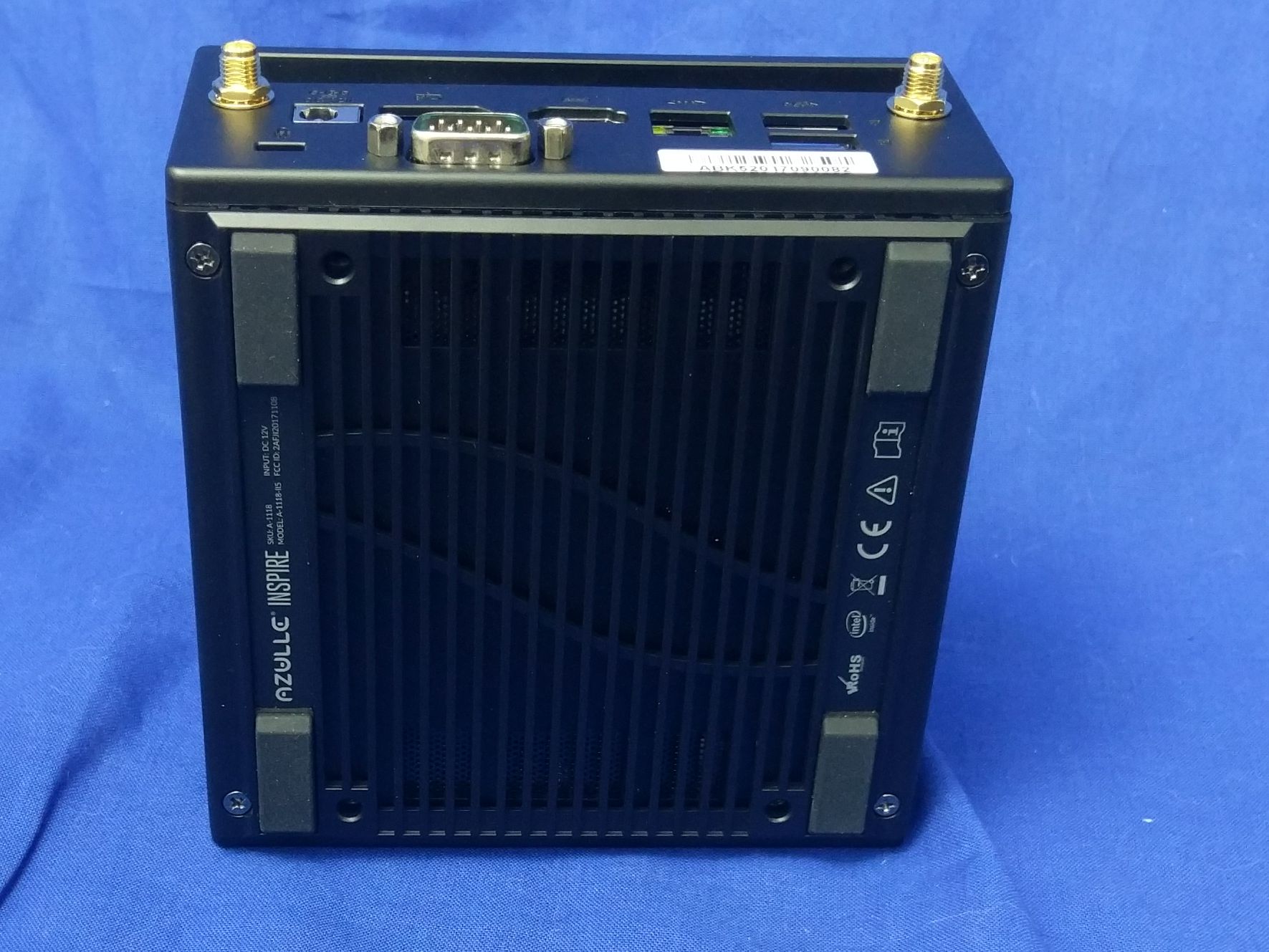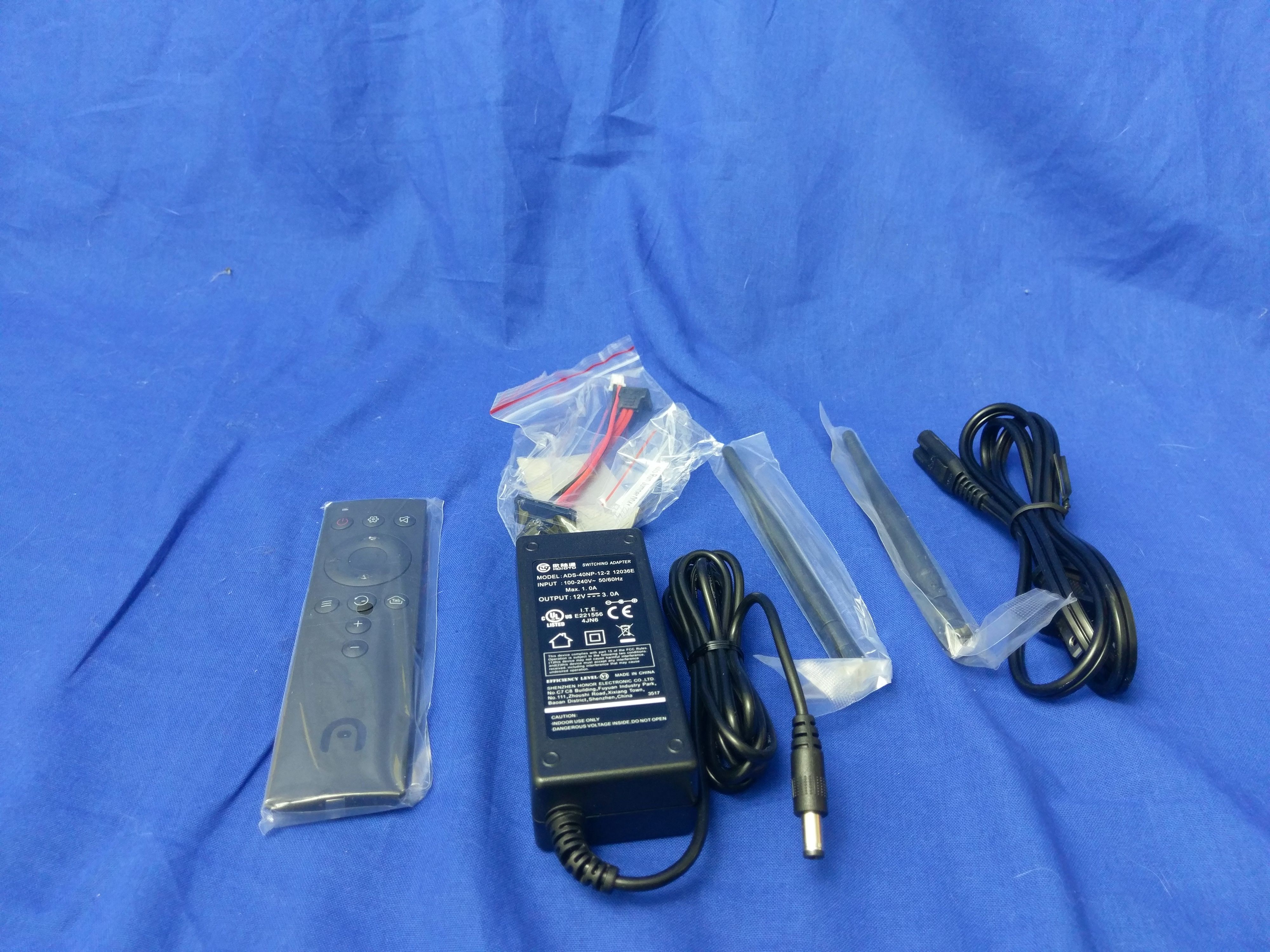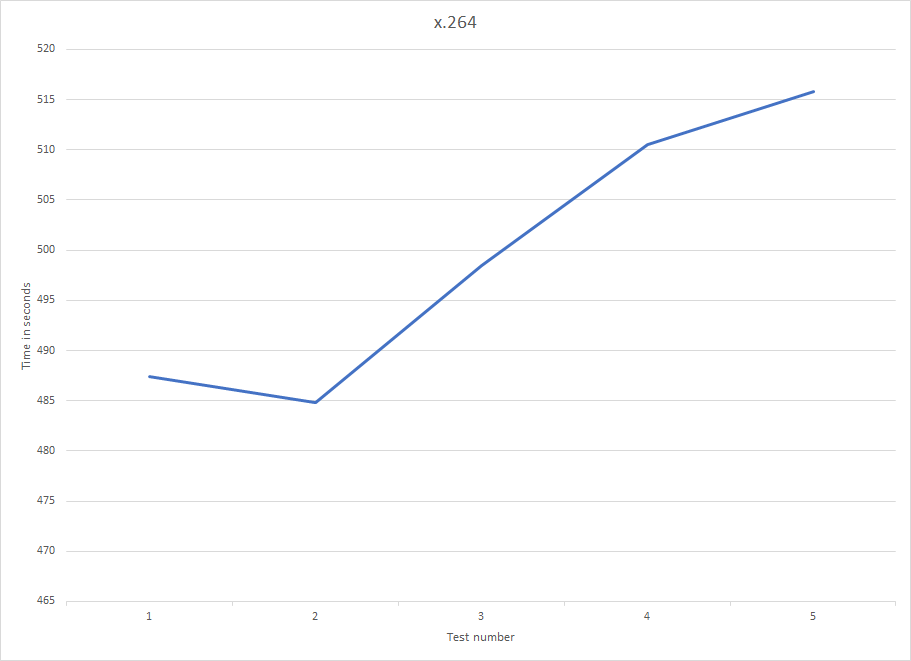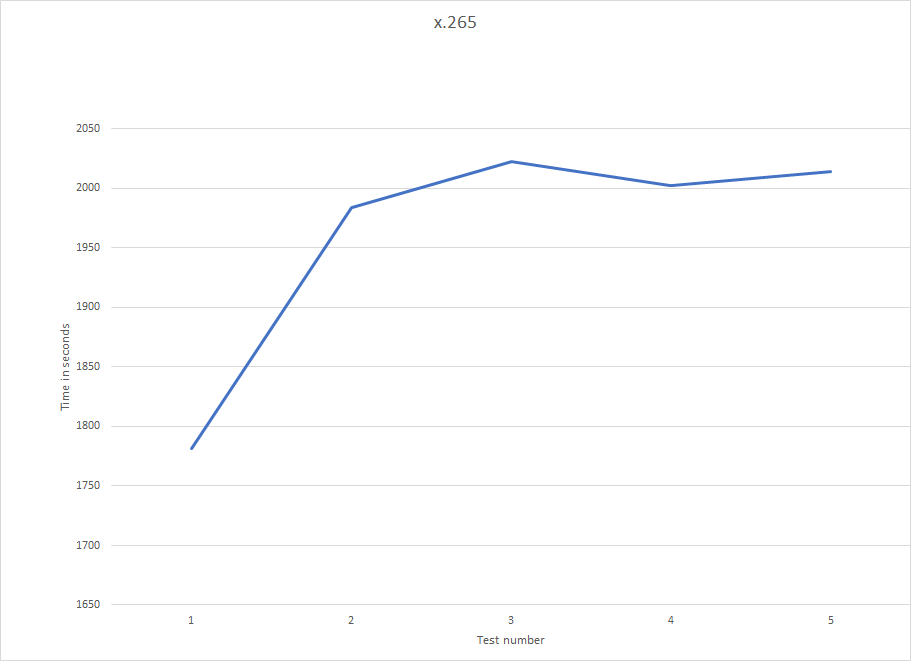Azulle Inspire reaching new fanless heights.
Insipred to reach new markets mini pc maker Azulle has sent us in their latest system for review. Sticking to their niche of fanless systems the Inspire is targeted at users who want more while using less offering a compact system with all of the modern trimmings.
Getting a look at the Inspire
From the outside the Inspire is clearly taking cues from industrial systems. Looking around we have a varied port selection with a some modern choices. However the total USB count is down from it’s sibling with the missing 2.0 port. We do get a full Size Displayport which is excellent as it supports 4k60 output. I would have gladly traded the VGA for a pair of USB 2.0 and/or a second gigabit Ethernet port however. The introduction of larger detachable antennas dual antennas should offer the Inspire superior wireless performance. Rounding off the accessories is a thermal pad for the m.2 ssd, a sata cable and the same remote we saw with the byte 3.
Specifications and comparison systems
| Inpsire | Inpsire | Access Plus | Byte Plus | |
|---|---|---|---|---|
| Baseline | As reviewed | As reviewed | As reviewed | |
| Cpu | Kabby lake i3-7100u | Kabby lake i5-7200u | Atom x5-Z8300 | Atom x5-Z8300 |
| Memory | Barebones | 16Gb 2133 | 4Gb | 4Gb |
| Storage | Barebones | 250Gb(950 evo) | 32GB emmc+128gb microSD | 32GB emmc+128gb microSD |
| Audio | Combo in/out 3.5mm | Combo in/out 3.5mm | Combo in/out 3.5mm | Combo in/out 3.5mm |
| Networking | Realtek PCIe Gigabit ethernet | Realtek PCIe Gigabit ethernet | Axxis usb2 Fast ethernet | Axxis usb3 gigabit ethernet |
| Intel 3165 Dual band AC wireless+Bluetooth | Intel 3165 Dual band AC wireless+Bluetooth | Intel 3160 Dual band AC wireless | Intel 3160 Dual band AC wireless | |
| Ports | 3 usb 3.0 | 3 usb 3.0 | 1 usb 3.0 | 2 usb 3.0 |
| 1 Com port | 1 Com port | 1 usb 2.0 | 1 usb 2.0 | |
| 1 HDMI | 1 HDMI | 1 HDMI | 1 HDMI | |
| 1 Display port | 1 Display port | 1VGA | 1VGA | |
| 1 USB Type-C | 1 USB Type-C | 1 Fast Ethernet | 1 Gigabit Ethernet | |
| 1 Kensington lock slot | 1 Kensington lock slot | 1 Kensington lock slot | 1 Kensington lock slot |
Our review unit is the middle of the 3 Inspire options. Honestly of the three this is the option that provides the most value per dollar. Moving from the i3 to the i5 is a 65 dollar upgrade and nets you hyper-threading as well as turbo boost. However the move from an i5 to an i7 at 115 usd only gets you some moderately increased clock rates which I don’t expect to be adventurous long term due to the limitations of a fanless design. The three cpu’s Azulle is using can be compared directly on Intel ARK. The best comparisons for the Inspire will be other Azulle systems. We’ll also be using our previous mobile storage test system, as a reference point.
Testing will be covering several applications where I would expect to see this system used in including signage, video playback , light gaming and emulation , as well as industrial applications. Industrial applications may seem an odd choice however considering the devices fanless nature it would fare very well in a shop. The lack of air fans means particulate including metallic fibers won’t be pulled into the system increasing it’s survivability.
Synthetic Performance
Starting with synthetic performance it’s a complete upset where the Inspire outperforms every other system we have in the lineup. Where the byte 3 was competitive with older systems the Inspire outshines laptops with active cooling that are only a few years old at this point. On the GPU side we see the Intel HD graphics posting similar results to the quadro 2000, a GTS 450 based gpu. For light openCL calculations the HD620 should perform very well. The reason the GTX470 looks odd is consumer drivers have limited compute capabilities compared to the professional quadro drivers. We’re going to skip storage performance for the Inspire since it’s entirely based on the choice of the user what SSD they use. The 950 evo sent for review was well beyond any fanless system we’ve looked at to date however.
Utilmaker Cura
Cura is a 3D slicing application. This means that it is used in the preparation of models to be printed on a 3D printer. Although this step can be done on the same PC that generated the models, it is quite common to in spaces where a 3D printer is shared between multiple systems of a dedicated system to this function. This allows a system to monitor the progress of the model as it is printed and to make adjustments and tweaks on the fly without having to go back to a primary production system.
The first model that we generated is the same sphere we used with the byte. Even with the constant reslicing the Inspire maintains a fluid workflow as we tune the model to get the desired print settings. Jumping to the more complex model with additional curves and interior surfaces it’s refreshing to see the Inspire not miss a beat. Where performance on a system like the byte 3 was adequate the Inspire is besting systems like the laptop I use every day
Office applications
As always I took time to use most of the office suite. I ran trough editing some larger spreadsheets(our SSD database) and well as some generic word processing. The Byte 3 impressed at such tasks with my only thoughts being it could use more room than it’s default internal storage. The same was true of simple picture and video manipulation.
Video Editing
While we took a peek at video editing with the byte 3 we’ve started using a new benchmark based on one of my favorite editing applications Shotcut. As video editing can be storage sensitive we’ll be testing each system with the fastest storage it has available to it. We’ll be adding this test to our SSD bench in the near future.
Looking at the average of 5 runs the Inspire didn’t fail to impress. My S1 yoga took almost twice as long to handle the same clip on the x264 run although the Inspire didn’t keep the same lead with x265. It’s possible the more strenuous codec caused thermal throttling for the cpu, or ssd in the fanless system so lets take a look at the individual runs.
Looking at the sub tests we see that later runs took longer thanks to the lack of active cooling. With the less stess the older codec showed smaller variances with a mere 30 second swing between the worst and best runs. x265 on the other hand kept both the CPU and SSD loaded for far longer periods of time showed a 233 second variance best to worst almost 4 minutes.
Gaming performance
As far as games are concerned I acknowledge that the Inspire is not equipped with a dedicated graphics card. The intel graphics in it are however fantastic compared to prior generations. Older games with higher settings and even some recent games should be more than manageable for the Inspire. In addition things that one may keep a older PC around for such as light emulation and a children’s PC are more than within the realm of capability for the Inspire.
Minecraft
Minecraft maybe ironically the newest application in our suite is it’s received constant updates since its release was most recently updated insert date here for the world of color update. With Minecraft running on a dedicated server we can see that the Inspire has no issues even on “fancy”. We see it’s bouncing well over 30FPS and trying to surpass 60 in some instances. Trying to move things to 4k unfortunately turned things to a slideshow once again. Unlike it’s smaller siblings the Inspire should have no issue acting as a host in a small multiplayer environment.
Homeworld 2 Remastered
Homeworld remastered represents a three dimensional real-time strategy game and is going to tax almost every function on the Inspire. Graphically it seems to have detected the Intel HD graphics and turn quite a bit of the eye candy down or off although that hasn’t left the models unpleasing it anyway, from a performance perspective I had no issues playing through multiplayer match the giving of the AI a bit of a trouncing . Performance in Homeworld feels smooth , I unfortunately don’t appear to have a frame rate quote for Homeworld. Once again HWR appears limited to the panels refresh, albiet with more eye candy this time
Startrek Online
Startrek online represents a modern MMO in our suite. Where the Byte3 had been rendered ineffective at 1080 thanks to a graphical update STO runs very well on the detected settings on the Inspire. It was a smooth and generally pleasant experience
Retro gaming
Project 64 and our video recorder unfortunately didn’t cooperate with each other. However in practice 5th gen(Nintendo 64, PS1 ect) and older consoles seem to run just fine on the intel chip. Taking a peek at the results it seems that there’s a bit of performance left on the table with only 2 cpu cores loaded by most emulators. However unlike it’s smaller sibling some newer emulators(like the gamecube) were playable. The wii although playable was more on a game per game basis likely due to the reliance on the IGP.
Video
The Inspire officially supports 4k decoding. In practice it handles this quite well for both local content and network based streams coming from a Plex server. Thanks to the increased cpu performance the Inspire can also serve 4k content for a single stream easily. However I’d still avoid it as a server if your library is more than a few TB. Going past 5TB in a system like the Inspire is difficult and offers no redundancy unless you use expensive external storage options.
Final thoughts
Looking at it, the Azulle Inspire takes most of of the strengths of the Byte 3 and builds upon them. Storage is expandable internally, wireless antennas are removable and I got my displayport connector. Adding CEC to the HDMI port by default would make this device an easy choice media centers. As with it’s smaller sibling I want to see features like power using USB-C. For users needing more cpu power, or who would have expanded the storage of it’s smaller siblings the Inspire is an obvious choice. The Inspire is available starting at 269.99 although many users would be benefited by a step up to the i5-7200u which we reviewed at 349.99.

